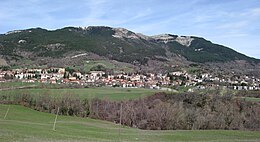Carpegna (brands)
| Carpegna | ||
|---|---|---|

|
|
|
| Country | Italy | |
| region | Brands | |
| province | Pesaro and Urbino (PU) | |
| Coordinates | 43 ° 47 ' N , 12 ° 20' E | |
| height | 748 m slm | |
| surface | 28.31 km² | |
| Residents | 1,649 (Dec. 31, 2019) | |
| Population density | 58 inhabitants / km² | |
| Post Code | 61021 | |
| prefix | 0722 | |
| ISTAT number | 041009 | |
| Popular name | Carpegnoli | |
| Patron saint | Anthony of Padua | |
| Website | Carpegna | |
Carpegna is an Italian municipality ( comune ) with 1649 inhabitants (as of December 31, 2019) in the province of Pesaro and Urbino in Marche . The municipality is located about 48 kilometers west-southwest of Pesaro and about 24.5 kilometers west-northwest of Urbino at the Parco naturale regional del Sasso Simone e Simoncello , belongs to the Comunità montana del Montefeltro and borders directly on the provinces of Arezzo ( Tuscany ) and Rimini ( Emilia-Romagna ).
history
According to legend, an Armileone Carpegna is said to have preserved the area from Odoacer in 466 and built a first castle. In 962 his descendant Ulderico di Carpegna is said to have received a fiefdom confirmation from Emperor Otto I for Carpegna and other possessions in Montefeltro and Romagna . A Rodolfo di Carpegna built Pennabilli Castle from 1004 and founded the Malatesta family . In the 12th century, the Counts of Carpegna (first mentioned as such in 1238) then split off from the Lords of Montecopiolo , who ruled a number of places in the Montefeltro region and became Counts with Montefeltrano I (approx. 1135 - 1202) raised by Montefeltro and enfeoffed in 1213 with the county of Urbino , where they rose to dukes in 1443. While the Carpegna had three blue diagonal stripes on silver in the coat of arms, the Montefeltro coat of arms placed them on gold. For a long time, the different family lines competed for supremacy in the region.
The Counts of Carpegna built and gradually acquired 30 castles. After the fall of the Hohenstaufen , the family split into the branches of the Counts of Carpegna-Gattara, who sided with the Guelphs , and the Counts of Carpegna-Pietracuta, who supported the Ghibellines . After the Gattara line died out in 1409, its rule briefly passed to the Malatesta, then back to the other Carpegna line, which in 1463 was again divided into two lines: the Counts of Carpegna (with Castellaccia, Palazzo Corignano and Torre dei Fossati) and the counts (from 1685 princes) of Gattara-Scavolino (with Gattara, Bascio, Miratoio and Scavolino). Both lines ruled rich immediate imperial fiefdom in imperial Italy .
In 1749 the Carpegna line died out in the male line and after lengthy disputes the Marchese Antonio Gabrielli inherited the county through his mother. The Napoleonic Kingdom of Italy (1805-1814) marked the end of imperial Italy and an interruption of sovereignty, in 1817 the Principality Gattara-Scavolino also fell then to the Counts Gabrielli-Carpegna, but in 1819 both territories were the Papal States incorporated. The family now lived mostly in Rome, where they bought two palazzi in (and a villa outside) the city. The descendants exist as the Princely House of Carpegna Falconieri Gabrielli and still own the Palace of Carpegna.
Web links
Individual evidence
- ↑ Statistiche demografiche ISTAT. Monthly population statistics of the Istituto Nazionale di Statistica , as of December 31 of 2019.



